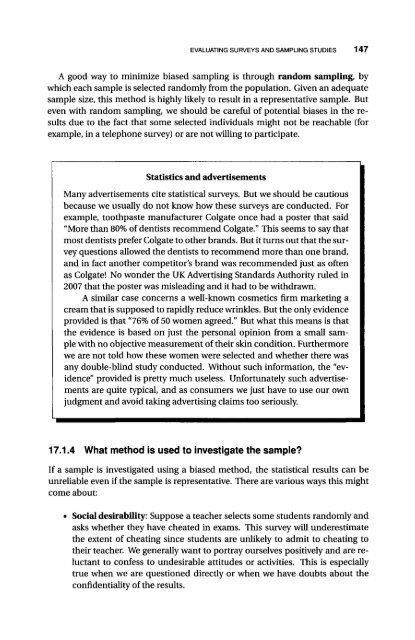An Introduction to Critical Thinking and Creativity - always yours
An Introduction to Critical Thinking and Creativity - always yours
An Introduction to Critical Thinking and Creativity - always yours
Create successful ePaper yourself
Turn your PDF publications into a flip-book with our unique Google optimized e-Paper software.
EVALUATING SURVEYS AND SAMPLING STUDIES 147<br />
A good way <strong>to</strong> minimize biased sampling is through r<strong>and</strong>om sampling, by<br />
which each sample is selected r<strong>and</strong>omly from the population. Given an adequate<br />
sample size, this method is highly likely <strong>to</strong> result in a representative sample. But<br />
even with r<strong>and</strong>om sampling, we should be careful of potential biases in the results<br />
due <strong>to</strong> the fact that some selected individuals might not be reachable (for<br />
example, in a telephone survey) or are not willing <strong>to</strong> participate.<br />
Statistics <strong>and</strong> advertisements<br />
Many advertisements cite statistical surveys. But we should be cautious<br />
because we usually do not know how these surveys are conducted. For<br />
example, <strong>to</strong>othpaste manufacturer Colgate once had a poster that said<br />
"More than 80% of dentists recommend Colgate." This seems <strong>to</strong> say that<br />
most dentists prefer Colgate <strong>to</strong> other br<strong>and</strong>s. But it turns out that the survey<br />
questions allowed the dentists <strong>to</strong> recommend more than one br<strong>and</strong>,<br />
<strong>and</strong> in fact another competi<strong>to</strong>r's br<strong>and</strong> was recommended just as often<br />
as Colgate! No wonder the UK Advertising St<strong>and</strong>ards Authority ruled in<br />
2007 that the poster was misleading <strong>and</strong> it had <strong>to</strong> be withdrawn.<br />
A similar case concerns a well-known cosmetics firm marketing a<br />
cream that is supposed <strong>to</strong> rapidly reduce wrinkles. But the only evidence<br />
provided is that "76% of 50 women agreed." But what this means is that<br />
the evidence is based on just the personal opinion from a small sample<br />
with no objective measurement of their skin condition. Furthermore<br />
we are not <strong>to</strong>ld how these women were selected <strong>and</strong> whether there was<br />
any double-blind study conducted. Without such information, the "evidence"<br />
provided is pretty much useless. Unfortunately such advertisements<br />
are quite typical, <strong>and</strong> as consumers we just have <strong>to</strong> use our own<br />
judgment <strong>and</strong> avoid taking advertising claims <strong>to</strong>o seriously.<br />
17.1.4 What method is used <strong>to</strong> investigate the sample?<br />
If a sample is investigated using a biased method, the statistical results can be<br />
unreliable even if the sample is representative. There are various ways this might<br />
come about:<br />
• Social desirability: Suppose a teacher selects some students r<strong>and</strong>omly <strong>and</strong><br />
asks whether they have cheated in exams. This survey will underestimate<br />
the extent of cheating since students are unlikely <strong>to</strong> admit <strong>to</strong> cheating <strong>to</strong><br />
their teacher. We generally want <strong>to</strong> portray ourselves positively <strong>and</strong> are reluctant<br />
<strong>to</strong> confess <strong>to</strong> undesirable attitudes or activities. This is especially<br />
true when we are questioned directly or when we have doubts about the<br />
confidentiality of the results.
















